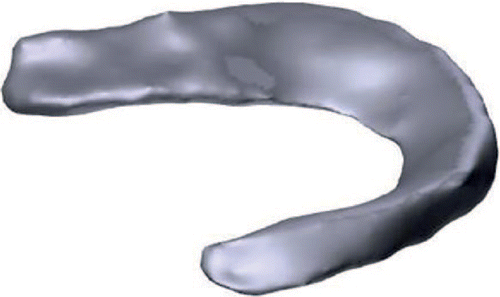 If you can sprint off for a pleasant morning run without wincing or heading for the pain reliever afterward, consider yourself lucky—and the envy of many who suffer from current or healing meniscus strain and injuries. Researchers at the Istituto Ortopedico in Rizzoli, Bologna, recently published findings in ‘Patient-specific meniscus prototype based on 3D bioprinting of human cell-laden scaffold,’ attempting to improve on current methods for making tissue repairs and replacement.
If you can sprint off for a pleasant morning run without wincing or heading for the pain reliever afterward, consider yourself lucky—and the envy of many who suffer from current or healing meniscus strain and injuries. Researchers at the Istituto Ortopedico in Rizzoli, Bologna, recently published findings in ‘Patient-specific meniscus prototype based on 3D bioprinting of human cell-laden scaffold,’ attempting to improve on current methods for making tissue repairs and replacement.
Authors G. Filardo, M. Petretta, C. Cavallo, L. Roseti, S. Durante, U. Albisinni, and B. Grigolo used real MRI scans from one patient and converted to the data into an .stl file, then proceeding to create a model from which to make the meniscus prototype and resulting scaffolds.
In operating on patients suffering from classic meniscus tears, the surgeon’s goal is usually to preserve as much healthy tissue as possible, while some may require total meniscectomies. Transplants today, however, are rife with all the typical challenges such as problems with rejection of the tissue, mismatch, and other issues such as impaired cellular infiltration. In this project, the researchers examined other challenges with scaffolds that have been previously created too, stating that only two types of artificial meniscus have made it to the clinical arena—one of which is a collagen implant, and the other constructed out of polyurethane and polycaprolactone. While they were both evaluated to be safe, and offered good results, the researchers point out that the ‘mismatch’ between implants and ‘patient-specific lesion areas’ is still a central problem.
“… it has been demonstrated that even small changes in implant positioning may affect contact pressure and joint stress,” stated the research. “To address the limits of meniscus implantation, and to optimize the restoration of meniscal function and joint integrity over time, implants could be developed with an enhanced biological potential and patient-specific sizing to meet individuals’ joint requirements.”
The researchers harvested bone marrow from a patient already scheduled for autologous cell transplantation, and watched cells expand and continue to thrive even after a week. The researchers used the 3D printed model of the knee to assist in reconstruction of the meniscus. They used a series of 2D cross sections to create tool paths, using LifeInk 200 bio-ink as the material for printing cells.
“The selected bio-ink presented good printability and shape fidelity, allowing the fabricated tissue, obtained by means of a microvalve-based inkjet dispensing technique, to mimic the anatomical model morphology,” stated the researchers. “This ‘cell-friendly’ technology allowed MSCs included in the bio-ink to be homogeneously distributed within the construct.”

Photograph of a custom-made, human, cell-laden, high-density collagen type I meniscus prototype after mesenchymal stem cells were embedded. The printing process was performed at room temperature in a Petri dish filled with culture medium and kept at 37°C.
After five days, only half of the cells were still alive, creating concerns about cell viability. Surprisingly though, almost the entire second half of the cells still alive were viable after 28 days.
“… these cells were able to grow and to colonize the biomaterial, demonstrating that the bioprinted collagen-based hydrogel scaffold provides a good microenvironment for the viability and proliferation of MSCs,” stated the researcher.
Overall, the research showed that this type of bioprinting shows the potential for tissue engineering with ‘anatomical precision.’ They do note, however, that several issues must be scrutinized in the future: density, cell encapsulation inside collagen gels, and collagen gel pore size.
“The prototype described in this study showed the biological potential of 3D bioprinting technology in providing an anatomically shaped, patient-specific construct with viable cells on a biocompatible material,” concluded the authors. “This study could act as the starting point for future developments of this custom-made, collagen-based, tissue-engineered structure, which could aid the optimization of implants designed to replace damaged menisci.”
Cartilage is a hot commodity for humans, and especially as the wear and tear of age begins to show, with this happening earlier for some of us. 3D printing shows huge potential to help with repairs, however, with new and promising methods for repairing defects, curing arthritis, bioprinting with knee stem cells to make new cartilage, and more. Find out more about advances in meniscus repairs here. What do you think of this news? Let us know your thoughts; join the discussion of this and other 3D printing topics at 3DPrintBoard.com.
[Source / Images: Patient-specific meniscus prototype based on 3D bioprinting of human cell-laden scaffold]
LIVE/DEAD images of cell-laden collagen type I gel scaffolds. Viable cells are in green and dead cells in red. The top row shows slides from total meniscus structure, while the bottom row shows slides from cubical constructs. Images are representative.
Subscribe to Our Email Newsletter
Stay up-to-date on all the latest news from the 3D printing industry and receive information and offers from third party vendors.
You May Also Like
AM Data Slice: 3D Printing Materials to Reach $3.9B in 2024
“AM Data Slice” from Additive Manufacturing Research (“AMR”) is a regular segment that offers readers an insightful dive into the additive manufacturing (AM) landscape, showcasing pivotal statistics and trends derived from...
3D Scanning in Rwanda to Enable Custom 3D Printed Prosthetics for Children
Artec 3D, one of the world’s leading original equipment manufacturers (OEMs) of 3D scanning hardware, has partnered with nongovernmental organization (NGO) Humanity & Inclusion (HI) on a project centered around...
3D Printing Webinar and Event Roundup: April 14, 2024
We’re starting off the week’s 3D printing webinars and events at ASTM AMCOE’s 11th Snapshot Workshop and MACH Exhibition. Stratasys continues its advanced training courses, SME is holding a virtual...
Onward for Velo3D with Optimistic Q1 Outlook, Gaining Momentum in Defense Sector
Just days after Velo3D (NYSE: VLD) revealed a brutal earnings report, the company is showing some signs of recovery, announcing bookings totaling $27 million since mid-December. What’s more, Velo3D shared...


































